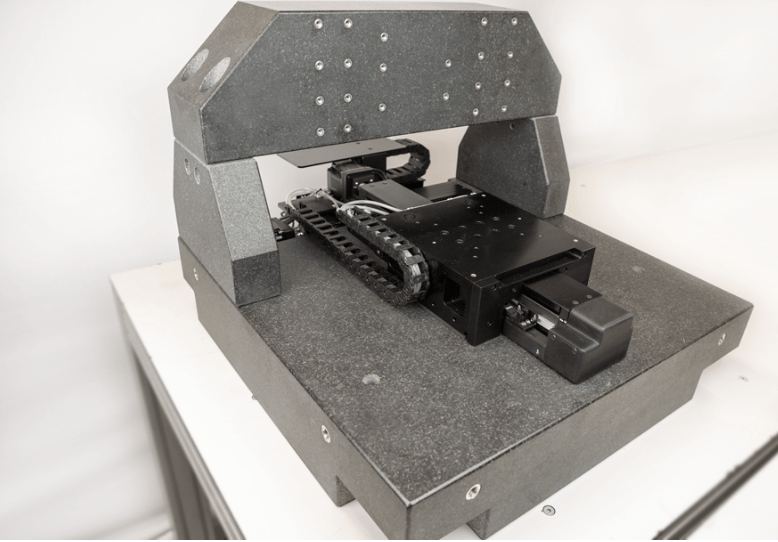The microscope market is expected to nearly double by 2028, surpassing the $20 billion mark.
Microscope application continues to widen from biological studies to non-organic matter, blurring the lines between the tech and medical industries. This significantly contributes to exponential microscope demand.
The more microscope technology and its applications grow, the more powerful microscope stages need to become. Stages have advanced in leaps and bounds from their first introduction, embracing motorization and automation technology. The most common of these are XY stages.
XY stages have been used by scientists for decades to make microscopes more effective. They are now more advanced than ever before, capable of nanometer movements.
As technology progresses, manufacturers introduce new features to keep their stages at the forefront of the market. They’re far more intricate and powerful now than they were even five years ago.
To help you keep up to date with the latest developments in XY stage technology, we’ve created this brief guide to high-performance XY stages. We’ll explain how they work, their wide range of applications, and how to choose the right stage for your needs. Read on for all you need to know about XY stages.
What Is an XY Stage?
XY stages are not limited to microscope usage. They’re an essential feature of linear motion engineering. They are a type of linear translation stage.
A linear translation stage moves by motorization in an ideal straight line. XY stages are motorized stages that can do this in two directions: the X and Y axis.
X stages also exist, which move on a single axis. And as the name suggests, XYZ stages can move in ideal straight lines in three directions.
For clarity, we’ll discuss XY stage usage in the context of microscope motion.
When a microscope user needs to move their slide, they can do so by hand. Outside of a high school science lab, that’s generally too primitive for scientific application. Powerful microscopes reach such high magnification levels that moving the specimen around requires more precision than the human hand can offer.
Therefore, a motorized and automated stage is used to move the slide around. It adjusts remotely and robotically according to the instructions it’s given. They need to be able to move across both the X and Y axis so that on a 2D plane, the user can move their slide up, down, left, and right.
This is an XY stage.
How XY Stages Work
How do XY stages achieve the movements needed for microscopy applications at such high speed? The answer is a combination of movement mechanisms and motors that differ from machine to machine.
XY Stage Mechanisms
The movement mechanisms allow the linear stages to move along the X and Y plane as flatly as possible. Stages commonly use one of the following four options to do this.
Rollers
Rollers are one of the most affordable solutions for moving your stages. However, they’re also one of the most basic; they allow for less accuracy than the other options.
They still have many applications, though, such as optics labs.
Crossed rollers are an upgraded version of the roller mechanism. They remain affordable but allow for more stability and reliability, increasing the application of rollers.
Ball Bearings
Like rollers, ball bearings are a cost-effective solution. They are also more versatile in the type of stage they work in, making them a popular choice.
Air Bearings
Air bearings are the advanced cousin of a ball bearing. They allow for some of the flattest movement possible in an XY stage.
For them to work to their full potential, they must be supported by the highest-grade equipment, such as a granite base. Therefore, they’re generally one of the most expensive options.
Flexure
XY stages that are flexure-guided, also known as piezo flexure stages, are known for their low wear. In theory, flexure systems won’t wear out but can be used infinitely. Of course, that also makes them one of the most expensive systems.
XY Stage Motors
Stage motors all achieve varying levels of accuracy and speed. Here are the two most common motors.
Stepper Motor
A stepper motor moves your linear stages in set stepped increments. It is the most basic and affordable of the two motors, but it is still highly effective. It requires fewer components to work and is better for slower-speed usage.
Servo Motor
Servo motors are more complex and require an encoder to work. But that makes them more accurate. They are also the more efficient of the two and are better suited to high-speed applications.
Types of XY Stages
Within the umbrella of XY translation stages exist several specific types of linear motors. These include integrated, stacked, and planar XY stages.
Stacked XY Stages
Stacked stages got their name because they’re made of two X stages stacked on top of each other. These two single-axis stages are stacked at opposing angles so that one serves as the Y-axis.
The advantages of a stacked stage include the flexibility of stacking two different models, each of which will offer its own strengths. The simplicity of the design also makes it one of the most affordable XY stage options.
Calibration can become an issue because two separate machines are involved. As the two stages are stacked, the top stage has less support, as it’s not sitting on a solid surface. Improperly cantilevering them can present further rolling and calibration issues.
However, the effects of these disadvantages are so microscopic that they’re still suitable for many applications. And there are ways to combat these problems.
One solution is using a gantry system. This specially designed stacked XY stage ensures each stage receives the support it needs. Rather than making an XY stage yourself, you’ve invested in a ready-made stacked system that is balanced and calibrated.
Integrated XY Stages
Also called monolithic stages, integrated stages operate the X and Y axis on one level rather than stacked on top of each other. This means they have a much lower profile and potentially are better suited to microscopy applications.
Open Frame XY Stages
Open frame XY stages are a type of integrated stage designed to allow for non-epifluorescence imaging. In other words, it has clear elements that will enable the slide to be illuminated from underneath.
The only notable limitation of any integrated stage is that it operates on mechanical bearings, as do stacked stages. These bearings are incredibly effective at leveling out microscopic changes on the surface so that the stage moves as linearly as possible. But mechanical bearings can only do so much.
For the very highest level of precision in moving on the XY plane, you need a planar stage.
Planar XY Stages
Planar stages are the most precise piece of axis linear equipment available today. Instead of using mechanical bearings on cross rollers, they run on air bearings. The best of these positioning stages achieves a flatness of 1µm or less.
What Makes an XY Stage High Performance?
Now you have a comprehensive understanding of XY positioning systems, the question is, “What makes an XY stage high-performance?”
There are many factors that mean a linear stage is high-performance. Often, the one users are most concerned with is flatness. An XY stage should stay as flat as possible, whether the application is microscopic or not.
But other measures matter to each industry differently. They include the following.
Straightness
Flatness is vital so that the XY stage remains on the XY plane. But added to that is the need for the stages to move in an ideal straight line on both the X and Y axis. The highest-performing stages achieve near-perfect straightness levels.
Perpendicularity
Straightness measures whether lines ever deviate from their X or Y axis. But perpendicularity expresses whether the two planes stay at a 90-degree angle from each other. The lower the perpendicularity score, the higher performing the machine.
Settling Time
Each combination of motor and mechanism has a different settling time. That is, how long it needs to pause in position and settle before it moves again.
A low settling time is essential if you need a product that moves at high speeds with no pauses between movements. But this isn’t necessary for all applications. You can still choose a high-performance XY stage with incredible flatness but a longer settling time.
Load Capacity
Load capacity is the weight that the machine can support. This is usually unimportant when dealing with positioning systems on a microscopic scale.
But as you will see, XY stages have many starkly different applications. Some models can support a high load, even up to 650 lbs, such as for use in aerospace engineering.
Speed
The speed at which linear stages move is inconsequential in some industries but crucial in others. High-speed stages require more expensive components to operate effectively but are a necessary investment for some applications.
Repeatability
A repeatability measure shows how accurately your machine will return to the same spot when the instructions are repeated. It must be fast and stop exactly where it’s told.
High bi-directional repeatability levels are particularly impressive, as they show that the stage accounts for backlash and other changes while remaining precise and accurate.
Lifetime
As with any product, higher-performing versions will last longer. They take less wear and can bear more use without needing maintenance, repairs, or replacement.
To decide whether you need low or high-wear elements, consider how much use your stages will get regularly. Also, be sure not to push your machine past its load capacity and other limits. That will help it to last as long as possible.
Applications of High-Performance XY Stages
A high-performance XY stage excels in each area the client needs. But that depends on the intended use of the stage. Here are some examples of XY stage applications and which high-performance elements are most necessary.
Automation and Robotics
Automated and even semi-automated stages make automation more efficient. In this application, speed, settling time, and repeatability are often crucial. They enable automation to run endlessly unattended because the stages can be relied upon to stay accurate.
Microscopy and Life Sciences
When working on the nanoscale, it’s all about the detail. Factors such as flatness, perpendicularity, and straightness all take high priority. A high-precision XY stage is critical.
Flatness is paramount because it significantly reduces optical focusing times if the stages always stay at the same height.
However, performance levels in load bearing are inconsequential. Speed may also not be a priority, depending on the specific application.
Medical Equipment
XY stages serve a variety of roles in the medical industry. One example is medical equipment positioning. Surgical equipment can be precisely positioned for use using overhead gantries.
In these cases, load capacity is crucial to take the weight of the equipment. At the same time, precision is necessary for areas such as straightness and perpendicularity. But factors like settling time may be less critical.
Semiconductor
As semiconductors get smaller and smaller, the engineered systems used to make them need to become more accurate. Precision factors, such as flatness, straightness, and perpendicularity, are crucial.
At the same time, the stages need to keep up with the pace required in manufacturing. So high speeds, minimal settling times, and repeatability need to be just as high performing.
XY Stages You Can Trust
Whether you’re looking for an X, XY, or XYZ stage, Motion Solutions is leading the market with its advanced offerings. Not only that, but we can custom-build XY stages specific to your needs.
If you haven’t been able to find the exact solution you need, ordering a custom stage will yield the best results. It ensures you can prioritize the factors you need to be high performing without buying the most expensive machine out there.
Get in touch with us today to let us know your requirements. We’ll begin developing a design for your needs right away.




